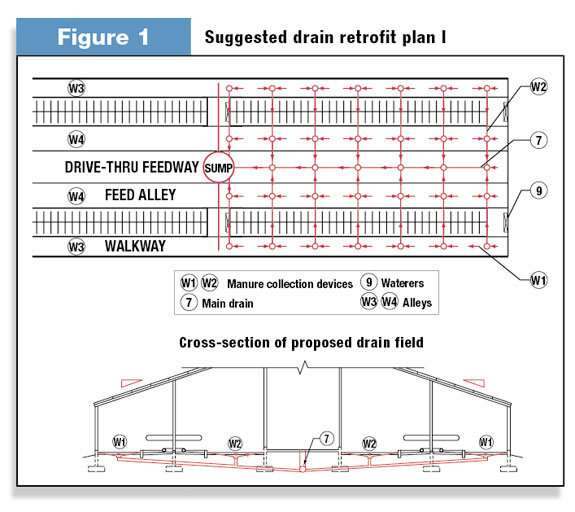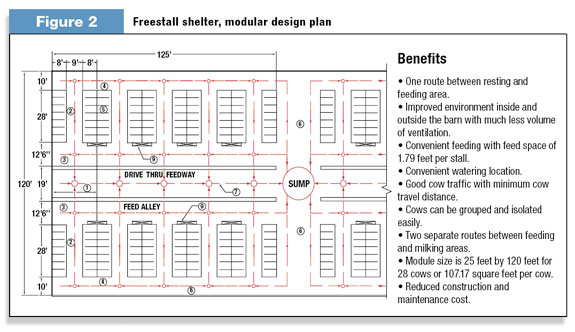The fundamental design for the dairy barn is to provide cow comfort, labor efficiency, economic viability and waste management efficiency. Solving the manure collection and removal problem will result in increasing productivity and a better environment.
One of the long-standing and costly problems of handling manure has been the absence of a simple, reliable, accurate and long-lasting system of manure collection and transportation out of the barn. The enterprise tendency to larger dairy production requires a number of radical changes and development of new methods for proper and efficient manure management.
In order to provide the industry with adequate manure-handling systems which will be both technically and economically competitive, it is necessary to:
- Develop the basic principles of design and construction of manure collection and transportation systems inside barns. The system should exclude manure storage in close proximity to cows in the barn and to keep the barn clean by applying plumbing technology principles – using water for flushing manure.
- Develop a manure reception structure with a flushing system, which will provide proper and automatic collection and removal of manure with minimum water consumption.
- Develop typical floor details and piping system for the purpose of transporting liquid manure to the sump. Structure unification should allow modular design of the barn to accommodate any productivity.
- Develop new methods of calculation and designing manure- handling systems to be completely automatic, that can be incorporated into a computerized control system.
- Rational use of water would allow for the reduction of the volume of wastewater. Most important it will allow selection of a proper manure treatment and utilization technology.
- New technology should require minimum farmer attention and could be run by unskilled personnel.
- The technology requires a multi-disciplinary research approach to focus on sustainability.
Extensive research and technological and development work permits consideration of the following approach. This dairy barn was designed by the University of Tennessee for a 300-cow freestall and feeding facility retrofit.
The barn floor is divided by sections for manure collection areas with minimum construction volume, and equipped with a flushing device. The manure-receiver area is equipped with a flushing system for fully-automatic removal of manure with moisture content in liquid of about 92 to 95 percent.
We developed a method of calculation permitted to design an efficient and reliable piping drainage system and manure collection fixtures, which will convey liquid manure to the sump.
The sump should have sufficient volume and be equipped with pumps and agitation system, which will provide agitation of liquid manure during the pumping period. Manure has to be pumped out from the barn automatically.
The water supply system should be designed to provide portable water for feeding, drinking, milking parlor and manure flushing. In a case where manure is treated and disinfected, the liquid can be used in a separate flushing system.
Since the barn engineering system is designed to be completely automatic, the controls of manure collection and removal should be incorporated into a computerized barn control system. This system will flush manure on-demand several times a day with full control of the flow rate of water. By employing it, livestock producers will be able to fully control and automatically operate manure collection and removal and provide much better sanitation for cows and environment for working personnel.
Water usage
Figuring a cow’s manure output at 18 gallons per day at 87 percent moisture, the volume of 15,000 gallons of flush water will need to be added to flush a 300-cow barn. Combined with the volume of manure, that results in 20,390 gallons of wastewater in a traditional flush system.
To achieve 95 percent moisture for wastewater, 14,000 gallons of flush water would need to be added, resulting in 19,400 gallons of total wastewater. To maintain the minimum of 92 percent for the proper process of gravity transportation, just 8,760 gallons of flush water will be added for a total wastewater volume of 14,148 gallons. That is 30 percent less compared to a conventional flush system.

Retrofit design
In the retrofit design (Figure 1), the feed and freestall alleys were divided by sections of 24 feet in length, or every six stalls, and a manure collection device was placed in each section. Maximum flush water needed for a 300-cow barn is 14,000 gallons in three to four discharges a day. The flushing devices work in sequence for about 60 seconds automatically.
Water supply piping design should be sized using conventional methods for design with maximum flow rate and velocity around 5 feet per second. Drainage piping design should be sized using conventional methods for gravity flow with a maximum flow rate and velocity minimum of 4 feet per second.
The calculation of water supply and drainage piping for the milking parlor and holding area are not included, but 10 to 15 percent of manure is collected in these areas, and it needs to be flushed several times a day.
Modular floor plan
The conventional freestall design configurations are two, three, four and six rows of stalls along a feed alley. This design assumed that manure would be moved along the alley by mechanical device or flushed with water to a gutter. The development of this new manure collection and removal system permits the dairy barn for a module layout for convenient cow movement, access to feed and water, freestalls and the milking center. See Figure 2. (Click the image to view at full size in a new window.)
In addition to the manure system benefits outlined above, characteristics of the modular layout include:
The proposed modular design also allows the barn to be built in stages and is easy to expand. It would be highly recommended to use precast concrete that is built to special specification for cow-friendly floors.
One important advantage of this design is excluding moving manure along the alley. This will help prevent spreading of diseases through manure.
Implementing this proposed flush system could ease some manure collection and removal problems, as well as provide additional benefits to the dairy. PD
References omitted due to space but are available upon request to editor@progressivedairy.com.
Aron Itkin is a researcher with A.I. Engineering Services. Email Aron Itkin.






